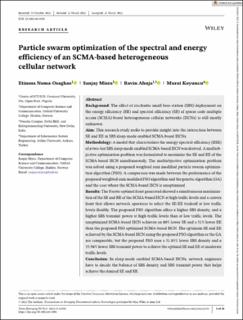| dc.contributor.author | Noma-Osaghae, Etinosa | |
| dc.contributor.author | Misra, Sanjay | |
| dc.contributor.author | Ahuja, Ravin | |
| dc.contributor.author | Koyuncu, Murat | |
| dc.date.accessioned | 2023-01-23T14:24:48Z | |
| dc.date.available | 2023-01-23T14:24:48Z | |
| dc.date.created | 2022-05-27T18:04:12Z | |
| dc.date.issued | 2022 | |
| dc.identifier.citation | Transactions on Emerging Telecommunications Technologies. 2022, 33 (9), Artikkel e4508. | en_US |
| dc.identifier.issn | 1124-318X | |
| dc.identifier.uri | https://hdl.handle.net/11250/3045432 | |
| dc.description.abstract | Background
The effect of stochastic small base station (SBS) deployment on the energy efficiency (EE) and spectral efficiency (SE) of sparse code multiple access (SCMA)-based heterogeneous cellular networks (HCNs) is still mostly unknown.
Aim
This research study seeks to provide insight into the interaction between SE and EE in SBS sleep-mode enabled SCMA-based HCNs.
Methodology
A model that characterizes the energy-spectral-efficiency (ESE) of a two-tier SBS sleep-mode enabled SCMA-based HCN was derived. A multiobjective optimization problem was formulated to maximize the SE and EE of the SCMA-based HCN simultaneously. The multiobjective optimization problem was solved using a proposed weighted sum modified particle swarm optimization algorithm (PSO). A comparison was made between the performance of the proposed weighted sum modified PSO algorithm and the genetic algorithm (GA) and the case where the SCMA-based HCN is unoptimized.
Results
The Pareto-optimal front generated showed a simultaneous maximization of the SE and EE of the SCMA-based HCN at high traffic levels and a convex front that allows network operators to select the SE-EE tradeoff at low traffic levels flexibly. The proposed PSO algorithm offers a higher SBS density, and a higher SBS transmit power at high traffic levels than at low traffic levels. The unoptimized SCMA-based HCN achieves an 80% lower SE and a 51% lower EE than the proposed PSO optimized SCMA-based HCN. The optimum SE and EE achieved by the SCMA-based HCN using the proposed PSO algorithm or the GA are comparable, but the proposed PSO uses a 51.85% lower SBS density and a 35.96% lower SBS transmit power to achieve the optimal SE and EE at moderate traffic levels.
Conclusion
In sleep-mode enabled SCMA-based HCNs, network engineers have to decide the balance of SBS density and SBS transmit power that helps achieve the desired SE and EE. | en_US |
| dc.language.iso | eng | en_US |
| dc.publisher | Wiley | en_US |
| dc.rights | Navngivelse 4.0 Internasjonal | * |
| dc.rights.uri | http://creativecommons.org/licenses/by/4.0/deed.no | * |
| dc.title | Particle swarm optimization of the spectral and energy efficiency of an SCMA-based heterogeneous cellular network | en_US |
| dc.type | Peer reviewed | en_US |
| dc.type | Journal article | en_US |
| dc.description.version | publishedVersion | en_US |
| dc.rights.holder | © 2022 The Authors. | en_US |
| dc.subject.nsi | VDP::Teknologi: 500::Informasjons- og kommunikasjonsteknologi: 550::Telekommunikasjon: 552 | en_US |
| dc.source.volume | 33 | en_US |
| dc.source.journal | Transactions on Emerging Telecommunications Technologies | en_US |
| dc.source.issue | 9 | en_US |
| dc.identifier.doi | 10.1002/ett.4508 | |
| dc.identifier.cristin | 2027803 | |
| dc.source.articlenumber | e4508 | en_US |
| cristin.ispublished | true | |
| cristin.fulltext | original | |
| cristin.qualitycode | 1 | |

